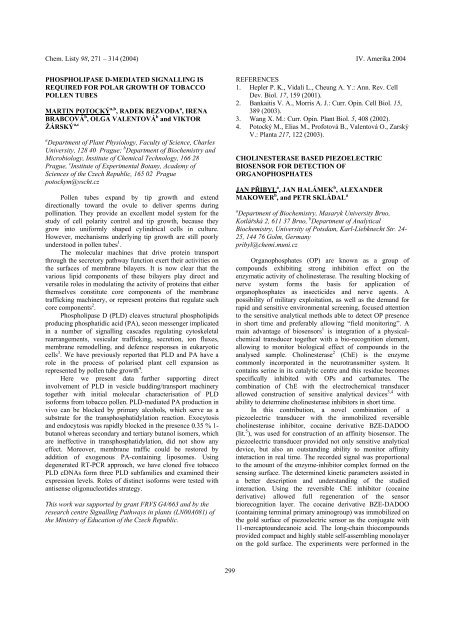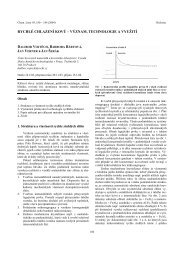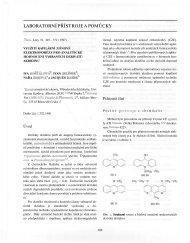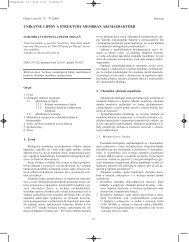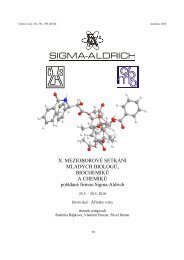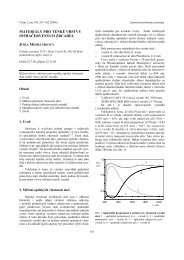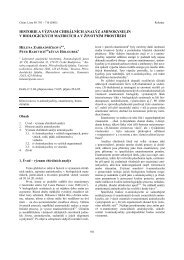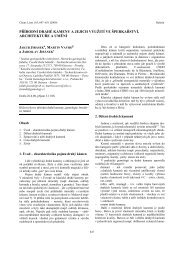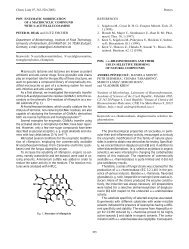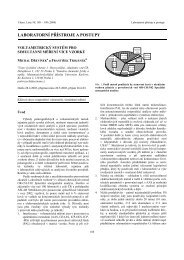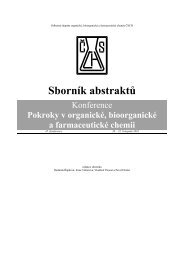iv. mezioborové setkênè mladðch biologů ... - Chemické listy
iv. mezioborové setkênè mladðch biologů ... - Chemické listy
iv. mezioborové setkênè mladðch biologů ... - Chemické listy
You also want an ePaper? Increase the reach of your titles
YUMPU automatically turns print PDFs into web optimized ePapers that Google loves.
Chem. Listy 98, 271 – 314 (2004) IV. Amerika 2004.<br />
PHOSPHOLIPASE D-MEDIATED SIGNALLING IS<br />
REQUIRED FOR POLAR GROWTH OF TOBACCO<br />
POLLEN TUBES<br />
MARTIN POTOCKÝ a,b , RADEK BEZVODA a , IRENA<br />
BRABCOVÁ b , OLGA VALENTOVÁ b and VIKTOR<br />
ŽÁRSKÝ a,c<br />
a Department of Plant Physiology, Faculty of Science, Charles<br />
Un<strong>iv</strong>ersity, 128 40 Prague; b Department of Biochemistry and<br />
Microbiology, Institute of Chemical Technology, 166 28<br />
Prague, c Institute of Experimental Botany, Academy of<br />
Sciences of the Czech Republic, 165 02 Prague<br />
potockym@vscht.cz<br />
Pollen tubes expand by tip growth and extend<br />
directionally toward the ovule to del<strong>iv</strong>er sperms during<br />
pollination. They provide an excellent model system for the<br />
study of cell polarity control and tip growth, because they<br />
grow into uniformly shaped cylindrical cells in culture.<br />
However, mechanisms underlying tip growth are still poorly<br />
understood in pollen tubes 1 .<br />
The molecular machines that dr<strong>iv</strong>e protein transport<br />
through the secretory pathway function exert their act<strong>iv</strong>ities on<br />
the surfaces of membrane bilayers. It is now clear that the<br />
various lipid components of these bilayers play direct and<br />
versatile roles in modulating the act<strong>iv</strong>ity of proteins that either<br />
themselves constitute core components of the membrane<br />
trafficking machinery, or represent proteins that regulate such<br />
core components 2 .<br />
Phospholipase D (PLD) cleaves structural phospholipids<br />
producing phosphatidic acid (PA), secon messenger implicated<br />
in a number of signalling cascades regulating cytoskeletal<br />
rearrangements, vesicular trafficking, secretion, ion fluxes,<br />
membrane remodelling, and defence responses in eukaryotic<br />
cells 3 . We have previously reported that PLD and PA have a<br />
role in the process of polarised plant cell expansion as<br />
represented by pollen tube growth 4 .<br />
Here we present data further supporting direct<br />
involvement of PLD in vesicle budding/transport machinery<br />
together with initial molecular characterisation of PLD<br />
isoforms from tobacco pollen. PLD-mediated PA production in<br />
v<strong>iv</strong>o can be blocked by primary alcohols, which serve as a<br />
substrate for the transphosphatidylation reaction. Exocytosis<br />
and endocytosis was rapidly blocked in the presence 0.35 % 1-<br />
butanol whereas secondary and tertiary butanol isomers, which<br />
are ineffect<strong>iv</strong>e in transphosphatidylation, did not show any<br />
effect. Moreover, membrane traffic could be restored by<br />
addition of exogenous PA-containing liposomes. Using<br />
degenerated RT-PCR approach, we have cloned f<strong>iv</strong>e tobacco<br />
PLD cDNAs form three PLD subfamilies and examined their<br />
expression levels. Roles of distinct isoforms were tested with<br />
antisense oligonucleotides strategy.<br />
This work was supported by grant FRVS G4/663 and by the<br />
research centre Signalling Pathways in plants (LN00A081) of<br />
the Ministry of Education of the Czech Republic.<br />
REFERENCES<br />
1. Hepler P. K., Vidali L., Cheung A. Y.: Ann. Rev. Cell<br />
Dev. Biol. 17, 159 (2001).<br />
2. Bankaitis V. A., Morris A. J.: Curr. Opin. Cell Biol. 15,<br />
389 (2003).<br />
3. Wang X. M.: Curr. Opin. Plant Biol. 5, 408 (2002).<br />
4. Potocký M., Elias M., Profotová B., Valentová O., Zarský<br />
V.: Planta 217, 122 (2003).<br />
CHOLINESTERASE BASED PIEZOELECTRIC<br />
BIOSENSOR FOR DETECTION OF<br />
ORGANOPHOSPHATES<br />
JAN PŘIBYL a , JAN HALÁMEK b , ALEXANDER<br />
MAKOWER b , and PETR SKLÁDAL a<br />
a Department of Biochemistry, Masaryk Un<strong>iv</strong>ersity Brno,<br />
Kotlářská 2, 611 37 Brno, b Department of Analytical<br />
Biochemistry, Un<strong>iv</strong>ersity of Potsdam, Karl-Liebknecht Str. 24-<br />
25, 144 76 Golm, Germany<br />
pribyl@chemi.muni.cz<br />
Organophosphates (OP) are known as a group of<br />
compounds exhibiting strong inhibition effect on the<br />
enzymatic act<strong>iv</strong>ity of cholinesterase. The resulting blocking of<br />
nerve system forms the basis for application of<br />
organophosphates as insecticides and nerve agents. A<br />
possibility of military exploitation, as well as the demand for<br />
rapid and sensit<strong>iv</strong>e environmental screening, focused attention<br />
to the sensit<strong>iv</strong>e analytical methods able to detect OP presence<br />
in short time and preferably allowing “field monitoring”. A<br />
main advantage of biosensors 1 is integration of a physicalchemical<br />
transducer together with a bio-recognition element,<br />
allowing to monitor biological effect of compounds in the<br />
analysed sample. Cholinesterase 2 (ChE) is the enzyme<br />
commonly incorporated in the neurotransmitter system. It<br />
contains serine in its catalytic centre and this residue becomes<br />
specifically inhibited with OPs and carbamates. The<br />
combination of ChE with the electrochemical transducer<br />
allowed construction of sensit<strong>iv</strong>e analytical devices 3,4 with<br />
ability to determine cholinesterase inhibitors in short time.<br />
In this contribution, a novel combination of a<br />
piezoelectric transducer with the immobilized reversible<br />
cholinesterase inhibitor, cocaine der<strong>iv</strong>at<strong>iv</strong>e BZE-DADOO<br />
(lit. 5 ), was used for construction of an affinity biosensor. The<br />
piezoelectric transducer provided not only sensit<strong>iv</strong>e analytical<br />
device, but also an outstanding ability to monitor affinity<br />
interaction in real time. The recorded signal was proportional<br />
to the amount of the enzyme-inhibitor complex formed on the<br />
sensing surface. The determined kinetic parameters assisted in<br />
a better description and understanding of the studied<br />
interaction. Using the reversible ChE inhibitor (cocaine<br />
der<strong>iv</strong>at<strong>iv</strong>e) allowed full regeneration of the sensor<br />
biorecognition layer. The cocaine der<strong>iv</strong>at<strong>iv</strong>e BZE-DADOO<br />
(containing terminal primary aminogroup) was immobilized on<br />
the gold surface of piezoelectric sensor as the conjugate with<br />
11-mercaptoundecanoic acid. The long-chain thiocompounds<br />
provided compact and highly stable self-assembling monolayer<br />
on the gold surface. The experiments were performed in the<br />
299


